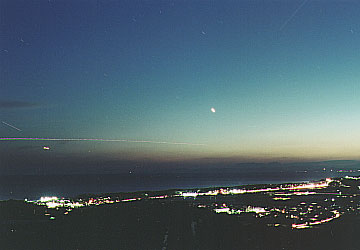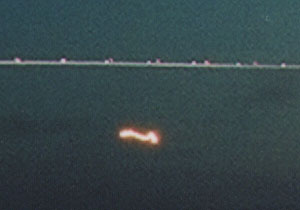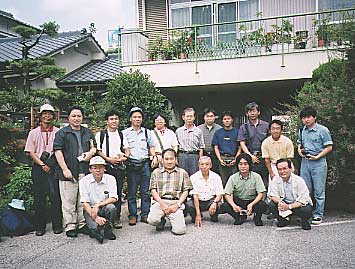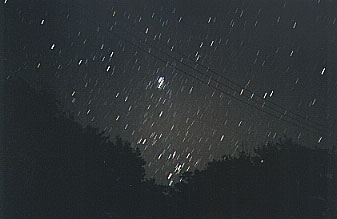
| Return |
| • September 23 It was an impressive sight. From the hill where the observatory stood I saw Venus hanging low in the southern sky in evening twilight. On the highway running along the beach cars' headlights left trails of light. In the reddish twilight sky I saw airplanes come and go. What is the source of that red light low over the southern ocean? It's been there on the same spot for as long as 5 minutes..? At 19:34 when the moon just rose, a huge fireball suddenly appeared and slowly proceeded from the zenith to the northeast. It was a greenish fire ball which resembled flare bombs I witnessed during the war. It was as bright as minus 6th magnitude. It lasted for about 7 or 8 seconds and disappeared. The trail of the meteor was brightly reflected on the observatory's 6-meter silver dome. Six visitors were with me at that time and their excited shouts echoed through the forest. Many people must have witnesses of this fireball. There was another fireball streaking to the south 30 minutes earlier tonight. |
 Looking to the south over the ocean from the observatory  The enlarged image of the point light source |
| • September 15 This morning, 90% of the observatory-tour participants came to our residence. Our small upstairs room was very crowded, but we had a lot to talk about. I showed them the Comet Award Medal and the friendship mirror(*1) from Mr. Ikeya, which I do not often show to visitors. I had them appreciate the mirror's reflectivity, the symbol of Mr. Ikeya's unchanging passion for the starry sky. In the afternoon we had a commemorative photo taken at the gates, then the visitors headed to other tourist spots. (*1) It was the first mirror Mr. Kaoru Ikeya (the co-discoverer of Comet Ikeya-Seki) ground in 1973. Its focal length is 661mm and the aperture 107mm. |
 A photograph at the gates |
|
• September 14 The weather has been good recently and I often observe from late at night to morning. What I am after at the moment is Comet Perrine-Mrkos, which has been missing more than 30 years. I have written about this comet many times in the past. Now this strange comet should be somewhere near the point of perihelion. On this tranquil morning the 60cm telescope is hunting the glow of the comet in the starry sky. The Pleiades is now high up in the sky and Sirius is shining above the southeastern horizon. The autumn has arrived in the heavens. |
 The rising Pleiades 2 am on September 9, 2002  Rising Sirius 4 am on September 4, 2002 Both photographs were taken at Geisei Observatory |
Copyright (C) 2002 Tsutomu Seki.